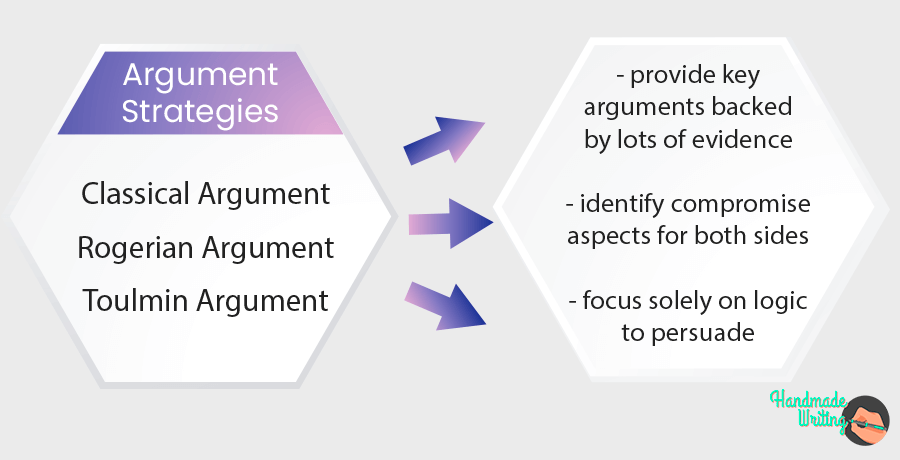Persuasive essays are similar to argumentative essays, so it can be easy to get them confused. But knowing what makes an argumentative essay different than a persuasive essay can often mean the difference between an excellent grade and an average one.
If you have the option to pick your own argumentative essay topic (which you most likely will), then choose one or two topics you find the most intriguing or that you have a vested interest in and do some preliminary research on both sides of the debate.
Though every essay is founded on these two ideas, there are several different types of essays, differentiated by the style of the writing, how the writer presents the thesis, and the types of evidence used to support the thesis statement.
Remember the differences between a persuasive essay and an argumentative one, make sure your thesis is clear, and double-check that your supporting evidence is both relevant to your point and well-sourced. Pick your topic, do your research, make your outline, and fill in the gaps. Before you know it, you'll have yourself an A+ argumentative essay there, my friend.
Persuasive Essay
Use the notes you made on the rough draft and go in and hack and smooth away until you're satisfied with the final result.
Theory is all well and good, but examples are key. Just to get you started on what a fully-fleshed out argumentative essay looks like, let's see some examples in action.
Your first task is to introduce the reader to the topic at hand so they'll be prepared for your claim. Give a little background information, set the scene, and give the reader some stakes so that they care about the issue you're going to discuss.

What this essay does well:
- Both sides of the argument are well developed, with multiple reasons why people agree with each side. It allows readers to get a full view of the argument and its nuances.
- Certain statements on both sides are directly rebuffed in order to show where the strengths and weaknesses of each side lie and give a more complete and sophisticated look at the argument.
After giving an overview of this type of essay, we provide three argumentative essay examples. After each essay, we explain in-depth how the essay was structured, what worked, and where the essay could be improved. We end with tips for making your own argumentative essay as strong as possible.
Remember, an essay can’t be an argumentative essay if it doesn’t support its argument with evidence. For every point you make, make sure you have facts to back it up. Some examples are previous studies done on the topic, surveys of large groups of people, data points, etc. There should be lots of numbers in your argumentative essay that support your side of the argument. This will make your essay much stronger compared to only relying on your own opinions to support your argument.
There are many ways payments could work. They could be in the form of a free-market approach, where athletes are able to earn whatever the market is willing to pay them, it could be a set amount of money per athlete, or student athletes could earn income from endorsements, autographs, and control of their likeness, similar to the way top Olympians earn money.
#1: Make Your Thesis Crystal Clear

Those against paying college athletes also believe that the athletes are receiving enough benefits already. The top athletes already receive scholarships that are worth tens of thousands per year, they receive free food/housing/textbooks, have access to top medical care if they are injured, receive top coaching, get travel perks and free gear, and can use their time in college as a way to capture the attention of professional recruiters. No other college students receive anywhere near as much from their schools.
Your college admissions essay may end up being one of the most important essays you write. Follow our step-by-step guide on writing a personal statement to have an essay that'll impress colleges.
The author begins by giving an overview of the counter-argument, then the thesis appears as the first sentence in the third paragraph. The essay then spends the rest of the paper dismantling the counter argument and showing why readers should believe the other side.
However, it would be a serious mistake to replace libraries with tablets. First, digital books and resources are associated with less learning and more problems than print resources. A study done on tablet vs book reading found that people read 20-30% slower on tablets, retain 20% less information, and understand 10% less of what they read compared to people who read the same information in print. Additionally, staring too long at a screen has been shown to cause numerous health problems, including blurred vision, dizziness, dry eyes, headaches, and eye strain, at much higher instances than reading print does. People who use tablets and mobile devices excessively also have a higher incidence of more serious health issues such as fibromyalgia, shoulder and back pain, carpal tunnel syndrome, and muscle strain. I know that whenever I read from my e-reader for too long, my eyes begin to feel tired and my neck hurts. We should not add to these problems by giving people, especially young people, more reasons to look at screens.

The body of your paper is the heart of your argument. Devote at least one paragraph to each of your ideas, go into details about both sides of the issue, and provide the most convincing counter-arguments.
Are you struggling with your argumentative essay? You are not alone. This type of academic writing is truly challenging, and most students experience hard times when trying to tailor one. However, you don’t have to worry – argumentation is an art, and you can master it. Think about your argumentative essay as if it was a dish. And in this article, you will find a winning recipe. The key ingredients of a delicious paper are:
You may reveal the opposing position first and then move to your own position as a correct one. Feel free to discredit and crush the opposing point with the facts you found during your research, just don’t use any aggressive language. Your points should be presented one by one, from the weakest to the strongest one. Support each of them with evidence, statistics, quotations, or even stories from real life – just make sure that they are convincing and relevant. Use reliable and fresh academic sources only.
To make your paper really strong, you need to assess both sides of the issue and work with them simultaneously. Find sufficient arguments for your side as well as for the opposing one – to beat them down like a boss. Even if you feel emotional about the topic, make sure to avoid dramatic language – provide facts, examples, and statistics. Interviewing topic experts might be a great idea, as well – their real-life experience is convincing and informative enough to help you structure a striking argument.
Get to work
Introduce and briefly explain your topic, give background details, intriguing statistics, and end your paragraph with a thesis statement. In your thesis statement, reveal your position about the topic.
End your paper with a summary of your central point and restate other supporting arguments. Don’t provide new information or quotes in your final paragraph.
Since you are writing an argumentative paper, you need to find a debatable topic – the one that has at least two debating points of view. Try to choose the topic you care about – being passionate about it, you will be more successful in your writing.
- Compelling topic

This argument structure dates back to the ancient Greeks and Romans. In this strategy, the arguer introduces the issue, provides context, clearly states their claim, provides key arguments backed by lots of evidence, and nullifies opposing arguments with valid data.
This essay identifies a particular value or belief and then examines how and why it is important to a particular cohort or a larger, general population.
One important way how this essay differs from other kinds is its specific nature. At the end of reading such an essay, the audience should clearly understand the issue or controversy and have enough information to make an informed decision regarding the issue. But what compels an audience make an informed decision? Several things!
It’s important not to confuse argumentative essay with a persuasive essay – while they both seem to follow the same goal, their methods are slightly different. While the persuasive essay is here to convince the reader (to pick your side), the argumentative essay is here to present information that supports the claim.
Claims of Value

With that in mind, we can now organize our argument into the essay structure.
A profile essay, or article, is a piece of journalistic-cum-literary writing. The aim is to present factual information on a given topic (person, place, animal, or event) while writing with an individual tone and style. In this article, we will expand on the concept of a profile essay. We will also tackle what a profile is and what purpose profiles serve. Finally, we will present strategies for preparing your research and strengthening your writing technique, as well as offer tips on structure and potential topics.
This essay often explores common questions associated with any type of argument including:

Once you have chosen a topic, think about both sides of the argument and make a list of points for each. This will help you shape your own argument and explain why your position is valid. The points from the list will serve as evidence of your validity. Pick your side of the issue and think of the central argument that backs it up. The task is to describe your argument as the right one and work against the opposing point, and explain why you disagree with it.
Since you are writing an argumentative paper, you need to find a debatable topic – the one that has at least two debating points of view. Try to choose the topic you care about – being passionate about it, you will be more successful in your writing.
The body of your paper is the heart of your argument. Devote at least one paragraph to each of your ideas, go into details about both sides of the issue, and provide the most convincing counter-arguments.
Are you struggling with your argumentative essay? You are not alone. This type of academic writing is truly challenging, and most students experience hard times when trying to tailor one. However, you don’t have to worry – argumentation is an art, and you can master it. Think about your argumentative essay as if it was a dish. And in this article, you will find a winning recipe. The key ingredients of a delicious paper are:
Find a sufficient evidence
When you are armed with information, start writing your paper. Like any other academic essay, an argumentative one contains three main parts:
End your paper with a summary of your central point and restate other supporting arguments. Don’t provide new information or quotes in your final paragraph.
- Compelling topic
